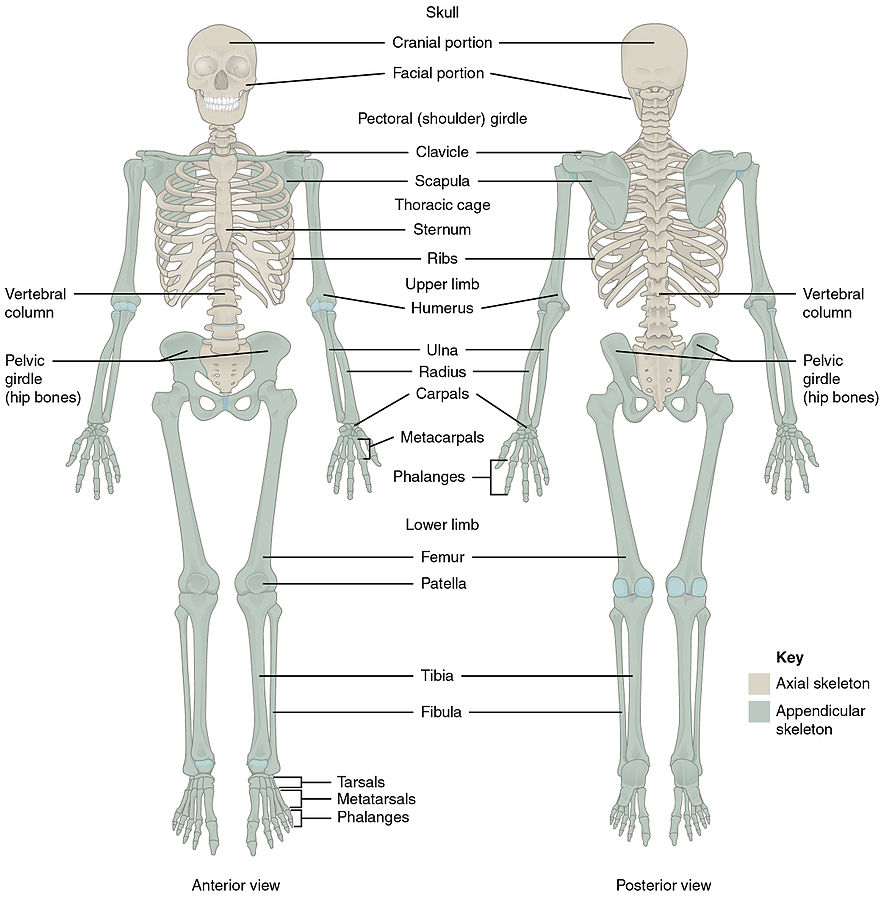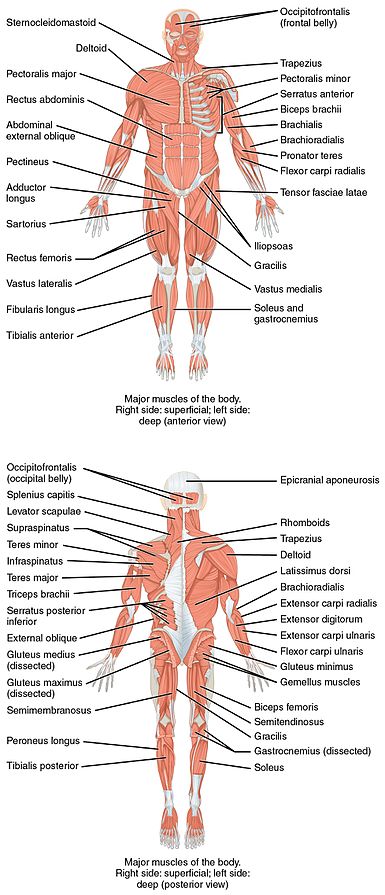11.6 Musculoskeletal System
The musculoskeletal system includes muscles, bones, and connective tissues. The human skeleton consists of 206 bones and other connective tissues called ligaments, tendons, and cartilage. See Figure 11.8[1] for an illustration of the major bones of the body. Ligaments connect bones to other bones, tendons connect bones to muscles, and cartilage provides bones with flexibility and acts as a cushion in the joints between bones.

The skeleton’s bones and connective tissues work together with muscles to provide a variety of functions and multiple types of movements. Gross motor skills are large movements controlled by the legs and trunk of the body. Fine motor skills are small movements such as those by the wrists and hands. The skeleton also provides structural support and protection for all the other organ systems in the body. The skull, or cranium, is like a helmet and protects the eyes, ears, and brain. The ribs form a cage that surrounds and protects the lungs and heart.[2]
In addition to producing movement, protecting organs, and providing structural support, the bones have several other functions. Bone marrow synthesizes red blood cells, white blood cells, and platelets, and bones store minerals such as calcium, phosphorus, and magnesium. Although bone tissue may look inactive at first glance, bones are continuously breaking down and reforming at the microscopic level. Bones also contain a complex network of canals, blood vessels, and nerves that allow for nutrient transport and communication with other organ systems.[3]
There are three types of muscle tissue, including skeletal muscle, cardiac muscle, and smooth muscle. Skeletal muscle produces movement, assists in maintaining posture, protects internal organs, and generates body heat. Skeletal muscles are voluntary, meaning a person is able to consciously control them, but they also depend on signals from the nervous system to work properly. See Figure 11.9[4] for an illustration of skeletal muscle. To move the skeleton, the tension created by the contraction of the skeletal muscles is transferred to the tendons, strong bands of dense, regular connective tissue that connect muscles to bones.[5]

Other types of muscles are involuntary and are controlled by the autonomic nervous system. Involuntary muscle includes the smooth muscle within the digestive system and respiratory system, as well as cardiac muscle in the heart that pumps blood throughout the body.[6]
Review sections Chapter 8.3, “Promoting Joint Mobility and Activity,” Chapter 9.4, “Complications of Immobility,” and Chapter 9.6, “Promoting Independence During ADLs” regarding problems that may occur in the musculoskeletal system, as well as how to assist clients in keeping the musculoskeletal system healthy. Remember that clients maintain range of motion, flexibility, and bone health by being as active as possible, especially with weight-bearing activity. Nursing assistants should promote ambulation as tolerated and encourage clients to move about independently as much as possible. Nursing assistants can also encourage protein diet choices to assist with tissue growth and repair and calcium to assist with bone health. Lean protein, such as low-fat meats and dairy products, are examples of healthy protein choices. Dairy products, soy milk, almond milk, and coconut milk are good sources of calcium, as well as green leafy vegetables like spinach, kale, and romaine.[7]
A common condition in the musculoskeletal system is osteoarthritis, a medical diagnosis that refers to inflammation of joints due to wear and tear throughout one’s life. Interventions that nursing assistants can perform to help alleviate discomfort associated with osteoarthritis are discussed in section Chapter 6.4, “Comfort Measures” and include measures such as ice, heat, topical medications, repositioning, and massage. Effectiveness of measures will vary by individual, so it is important to allow each individual to choose what is most helpful to alleviate their arthritis.
- “701 Axial Skeleton-01.jpg” by OpenStax is licensed under CC BY 3.0 ↵
- This work is a derivative of Human Nutrition by University of Hawai‘i at Mānoa Food Science and Human Nutrition Program and is licensed under CC BY NC SA 4.0 ↵
- This work is a derivative of Human Nutrition by University of Hawai‘i at Mānoa Food Science and Human Nutrition Program and is licensed under CC BY NC SA 4.0 ↵
- “1105 Anterior and Posterior Views of Muscles.jpg” by OpenStax is licensed under CC BY-SA 4.0 ↵
- This work is a derivative of Human Nutrition by University of Hawai‘i at Mānoa Food Science and Human Nutrition Program and is licensed under CC BY NC SA 4.0 ↵
- This work is a derivative of Human Nutrition by University of Hawai‘i at Mānoa Food Science and Human Nutrition Program and is licensed under CC BY NC SA 4.0 ↵
- This work is a derivative of Human Nutrition by University of Hawai‘i at Mānoa Food Science and Human Nutrition Program and is licensed under CC BY NC SA 4.0 ↵
Large movements controlled by the legs and trunk of the body.
Small movements such as those in the wrists and hands.
Muscle that produces movement, assists in maintaining posture, protects internal organs, and generates body heat.
Strong bands of dense, regular connective tissue that connect muscles to bones.
Muscles controlled by the autonomic nervous system, including smooth muscle within the digestive system and respiratory system and the cardiac muscle in the heart that pumps blood throughout the body.
Muscle within the digestive system and respiratory system.
Muscle found in the heart.
Type of arthritis causing inflammation or swelling of the joints due to daily wear and tear on the body.

